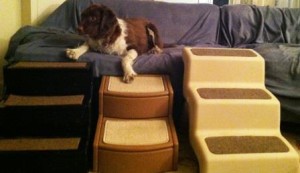Does your dog look at you, pleading for help as he contemplates jumping onto the couch or bed? Does he hesitate to jump down? It may be time to buy stairs for your dog. They are a good investment in your pet’s health and your piece of mind. Just think of what vet visits cost if your dog hurts his back as he tries to jump, or makes his arthritis worse as he lands hard on his front legs. Think of the lost quality time together, cuddling on the couch.

As Cassie, my springer spaniel, has gotten older and more arthritic, I have purchased multiple sets of steps for her, first for our bed, then years later for each couch. Since I own several brands, I have learned a few things about dog stairs.
- First, determine if your dog will use them. Cassie was an agility dog and was very used to climbing things, so she had no hesitation with using the stairs once I guided her up and down them with a treat a few times. My two cockers, Buffy and Chipper, refuse to use them, although they are young enough that they don’t need them.
- Next, make sure the stairs are sturdy. This is critical. Not only for your dogs, but kids love to step on them.
- The first one that I purchased (on the right) is one unit and is very sturdy. A small adult could walk on them. Unfortunately, I couldn’t find this model anymore and had to purchase other brands.
- The dark brown one on the left has fallen apart numerous times and my husband has had to drill additional screws in fix them. The stairs flip-up to create storage space, which is probably why it is the weakest of the models that I own.
- The two-step mode is much sturdier than it initially appeared. This one is low-cost and widely available. I recommend this one, at least in the two-step model.
- Determine the height needed. Two steps will often work for couches and chairs since the last step is onto the furniture. My bed is quite high and it required the three-step model.
Dog stairs are a good investment. Don’t think your dog is lazy and just doesn’t want to jump. It probably hurts him to do so. Better to be proactive to prevent injury than to make your pet suffer.

